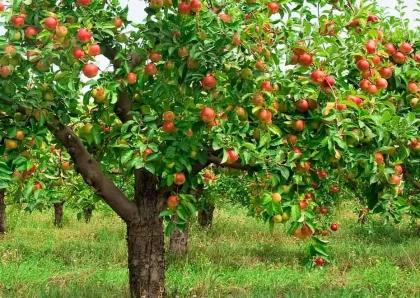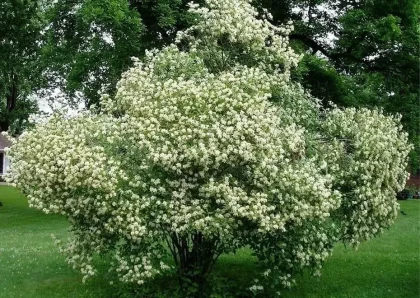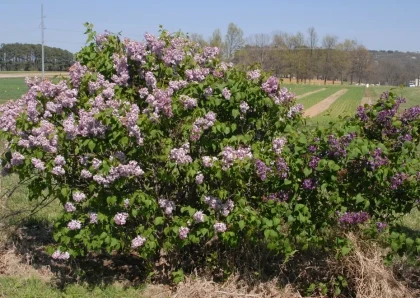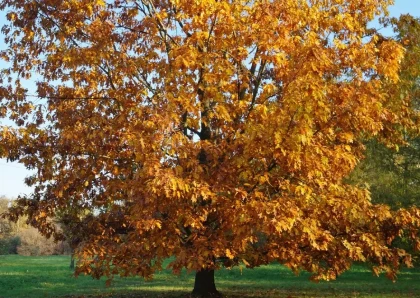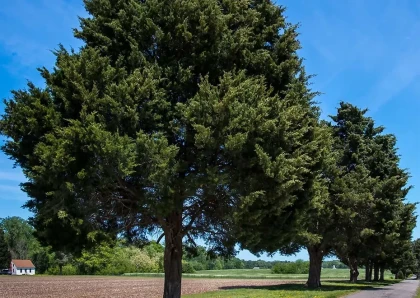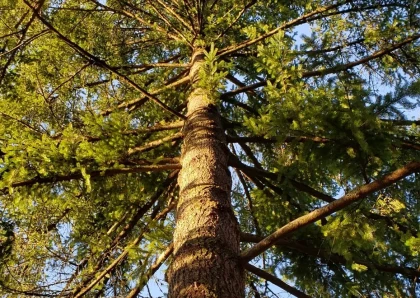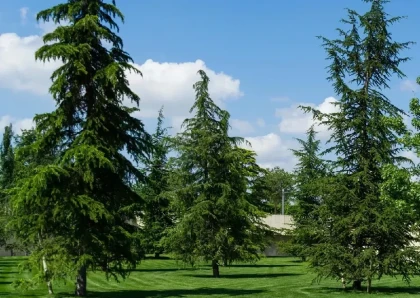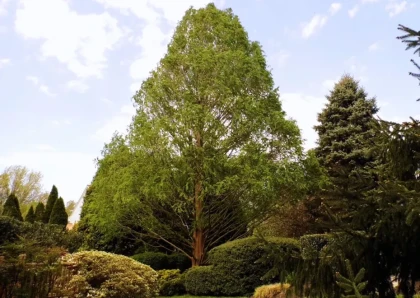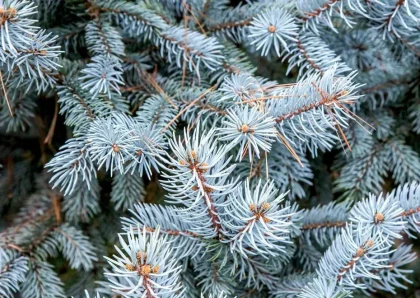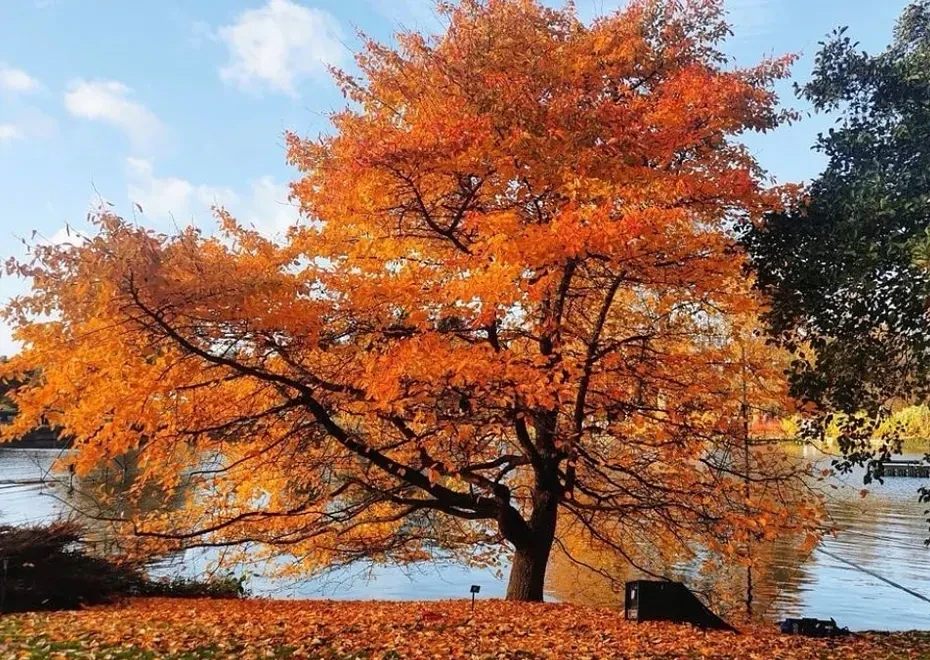
Black Tupelo Tree
Overview
The Black Tupelo tree, scientifically known as Nyssa sylvatica, is a captivating deciduous tree native to North America. Commonly referred to as black gum or sour gum, this tree is renowned for its striking autumn foliage and its adaptability to various soil types, thriving in both upland and wetland environments. Black tupelo trees typically reach heights of 30 to 50 feet, with a symmetrical, pyramidal crown that transforms into a dazzling display of vibrant red, orange, and purple hues come fall. Its elliptical, glossy green leaves provide ample shade during the warmer months, and the tree produces small, bluish-black fruits that are a valuable food source for wildlife, including birds. With a slow to moderate growth rate, black tupelo tree is valued for their ornamental beauty in landscaping and their ecological importance in supporting biodiversity. Additionally, the hardwood of the black tupelo is used in furniture-making and woodworking due to its fine texture and resistance to decay. Overall, the black tupelo stands as a testament to the beauty and resilience of native flora in North America.
Key Features and Characteristics
- Leaves:
- The leaves are simple, alternate, and elliptical in shape.
- They are typically dark green in the summer and turn brilliant shades of red, orange, and purple in the fall, making it a popular ornamental tree for autumn foliage.
- Bark:
- The bark is dark gray to black, deeply furrowed, and has an interesting blocky appearance.
- As the tree ages, the bark becomes even more distinctive.
- Form:
- Black tupelo trees have a pyramidal to oval-shaped crown when young, maturing into a more rounded form.
- They usually reach a height of 30 to 50 feet, though some specimens can grow taller.
- Flowers:
- The tree is dioecious, meaning that individual trees are either male or female.
- Inconspicuous greenish-white flowers appear in the spring.
- Fruits:
- Female trees produce small, dark blue to black drupe fruits.
- These fruits are an important food source for various wildlife, including birds.
- Habitat:
- Black tupelo trees are adaptable to various soil types, but they thrive in moist, acidic soils.
- They are commonly found in wetland areas, along stream banks, and in lowland forests.
- Wildlife Value:
- The tree provides habitat and food for a variety of wildlife, including birds and mammals.
- Birds are attracted to the fruit, and the dense foliage provides good cover.
- Fall Color:
- One of the outstanding features of the black tupelo is its brilliant fall foliage.
- The leaves can turn vibrant shades of red, orange, yellow, and purple, making it a visually striking tree in the autumn landscape.
- Landscape Use:
- Black tupelo is often planted as an ornamental tree in urban and suburban landscapes for its aesthetic appeal, especially during the fall season.
- Wood:
- The wood of black tupelo is hard, tough, and strong.
- It has been used for various purposes, including furniture, flooring, and tool handles.
Different Types/Varieties of Black Tupelo Tree
1. Nyssa sylvatica 'biflora' (Swamp Tupelo or Swamp Black Gum)
This variety is adapted to wetter habitats, such as swamps and bottomlands. It has similar features to the common Black Tupelo but is more tolerant of wet soil conditions.
2. Nyssa sylvatica 'Haynesville' (Haynesville Black Gum)
This cultivar is known for its attractive columnar or narrow pyramidal shape, making it a popular choice for urban landscapes and small garden settings.
3. Nyssa sylvatica 'Wildfire' (Wildfire Black Gum)
This cultivar is sought after for its stunning fall foliage, which exhibits fiery red colors. The leaves of 'Wildfire' turn bright red earlier in the season compared to the common Black Tupelo.
4. Nyssa sylvatica 'Green Gable' (Green Gable Black Gum)
This cultivar is valued for its consistent pyramidal shape, glossy green leaves, and good resistance to diseases.
5. Nyssa sylvatica 'Afterburner' (Afterburner Black Gum)
Another cultivar known for its exceptional fall color display. The leaves turn shades of bright red, orange, and purple, creating a captivating visual spectacle.
6. Nyssa sylvatica 'Autumn Cascades' (Autumn Cascades Black Gum)
This cultivar is prized for its cascading growth habit and vibrant fall foliage in shades of red, orange, and yellow.
7. Nyssa sylvatica 'Red Rage' (Red Rage Black Gum)
Another cultivar prized for its intense red fall coloration. This variety is often sought after for landscaping to add a burst of vibrant color to the autumn landscape.
Wood Products from Black Tupelo Tree
Furniture
Black Tupelo wood is used to create furniture items such as tables, chairs, cabinets, and dressers. Its strong and close-grained nature makes it suitable for crafting durable and long-lasting furniture pieces.
Veneer
Black Tupelo wood is often sliced into thin sheets to create veneer, which is then used to cover the surfaces of furniture, cabinets, and other decorative items. Veneer provides an attractive wood finish while making the most of the available wood.
Flooring
The wood is utilized to make hardwood flooring. Its hardness and appealing grain patterns contribute to beautiful and resilient floors.
Panelling
Black Tupelo wood can be used for interior wall paneling, adding a natural and warm aesthetic to homes and buildings.
Cabinetry
It is a popular choice for crafting kitchen cabinets and other storage units due to its strength and durability.
Musical Instruments
Black Tupelo wood is occasionally used in the construction of musical instruments such as guitars and mandolins. Its acoustic properties contribute to the instrument's tone.
Tool Handles
The wood's strength and resistance to wear make it a suitable material for tool handles, including hammers, axes, and chisels.
Carvings and Turnings
Black Tupelo wood can be carved and turned into decorative items like sculptures, bowls, and other artistic pieces.
Wood Crafts
It is used in crafting various wooden objects, including toys, ornaments, and home decor items.
Benefits of the Black Tupelo Tree
- Erosion Control: The extensive root system of black tupelo helps prevent soil erosion, making it a valuable tree for stabilizing stream banks and other areas prone to erosion.
- Wildlife Habitat: The tree provides habitat and food for various wildlife species. Birds are attracted to the fruit, and the dense foliage offers shelter for nesting.
- Fall Foliage: Black tupelo is known for its spectacular fall foliage, with leaves turning vibrant shades of red, orange, yellow, and purple. This makes it a popular choice for landscaping and adds aesthetic value to urban and suburban areas.
- Adaptability: Black tupelo is adaptable to a range of soil types, including wet soils. Its ability to grow in different environments makes it suitable for landscaping in various regions.
- Tolerance to Flooding: This tree exhibits a degree of tolerance to flooding, which can be beneficial in areas with fluctuating water levels.
- Wood Utilization: The wood of black tupelo is hard and has been historically used for various purposes, including furniture, flooring, and tool handles.
- Carbon Sequestration: Like all trees, black tupelo contributes to carbon sequestration, helping to mitigate the effects of climate change by absorbing and storing carbon dioxide from the atmosphere.
- Water Quality Improvement: Planting black tupelo trees along water bodies can help improve water quality by filtering pollutants and reducing runoff.
- Landscaping Value: The ornamental qualities of the black tupelo, particularly its striking fall foliage, make it a desirable choice for landscaping in parks, gardens, and residential areas.
- Cultural Significance: The black tupelo has cultural significance in some Native American traditions. It has been used for various purposes, including in herbal medicine.
- Biodiversity Support: By providing food and habitat for wildlife, the black tupelo contributes to the overall biodiversity of ecosystems where it is present.
- Disease Resistance: Black tupelo trees are generally hardy and can resist certain diseases, contributing to their overall health and longevity.
Tips for Planting and Maintaining Black Tupelo Tree
- Choose the Right Location: Select a planting site that receives full to partial sun and has well-draining, moist, acidic soil. Avoid planting in areas prone to standing water.
- Planting Time: Plant the Black Tupelo tree in the spring or fall to give it enough time to establish its root system before extreme weather conditions.
- Proper Planting Technique: Dig a hole slightly larger than the root ball, place the tree in the hole, and backfill with soil. Water thoroughly after planting to help settle the soil.
- Watering: Keep the tree well-hydrated, especially during the first growing season. Water deeply but infrequently to encourage deep root growth.
- Mulching: Apply a layer of organic mulch around the base of the tree, but avoid piling it against the trunk. Mulch helps retain soil moisture and suppress weeds.
- Pruning: Prune the Black Tupelo tree minimally, primarily to remove dead or damaged branches. Avoid heavy pruning, especially during the growing season.
- Fertilization: In most cases, the Black Tupelo does not require regular fertilization. If necessary, use a balanced, slow-release fertilizer, and follow the manufacturer's instructions.
- Protect from Pests and Diseases: Monitor the tree regularly for signs of pests or diseases. Take appropriate measures, such as using insecticidal soap or contacting an arborist, if issues arise.
- Support Young Trees: Stake young Black Tupelo trees if needed to protect them from strong winds or help them grow straight. Remove the stakes once the tree is well-established.
- Seasonal Care: Provide extra care during extreme weather conditions, such as hot, dry summers or harsh winters, to ensure the tree's health and vitality.
Cons of Planting Black Tupelo Tree
- Limited Geographic Distribution: The Black Tupelo Tree is native to eastern North America, so it may not be suitable for planting in regions outside of its natural range. Its limited geographic distribution may restrict its availability in certain areas.
- Slow Growth Rate: Black Tupelo trees have a relatively slow growth rate compared to some other tree species. This slow growth can be a disadvantage if fast-growing trees are desired for certain landscaping or reforestation projects.
- Messy Fruits: While the fruits of the Black Tupelo are valuable as a food source for wildlife, they can be messy when they drop from the tree, potentially creating a litter issue in some landscapes.
- Susceptibility to Pests and Diseases: Like all trees, Black Tupelo is susceptible to certain pests and diseases. While it is generally considered a hardy tree, it may face challenges from specific insects or pathogens in certain environments.
- Shallow Root System: The Black Tupelo tree has a shallow root system, which can make it more susceptible to wind damage or uprooting during severe weather conditions.
- Limited Urban Tolerance: While Black Tupelo trees can be used in urban and suburban settings, they may not tolerate certain urban stressors, such as pollution, compacted soil, or limited root space, as well as some other tree species.
- Allergenic Potential: The pollen produced by the Black Tupelo tree may cause allergies in some individuals, particularly during its flowering period in spring.
- Fallen Leaves in Autumn: While the vibrant fall foliage of the Black Tupelo is a desirable feature, the dropping of leaves during autumn can require regular cleanup in certain settings, such as in urban areas with sidewalks or near buildings.
- Specific Soil Requirements: Black Tupelo trees prefer moist, acidic soils with good drainage. In areas with different soil conditions, it may require additional soil amendments or maintenance to support healthy growth.
- Limited Commercial Availability: Due to its slow growth and specific habitat requirements, the Black Tupelo tree may not be as readily available for commercial purposes compared to more common tree species.
Conclusion
The Black Tupelo tree, scientifically known as Nyssa sylvatica, stands as a remarkable and ecologically valuable species of deciduous hardwood native to eastern North America. Its medium to large-sized form, stunning fall foliage, and abundant fruiting make it a favored choice in various landscapes, from woodlands to urban parks. The Black Tupelo plays a crucial role in supporting local ecosystems, providing habitat and nourishment for diverse wildlife, including birds, bees, butterflies, and mammals. Moreover, its dense canopy offers cooling shade during hot summer months and contributes to carbon sequestration, aiding in mitigating the effects of climate change. With its strong, close-grained wood, the Black Tupelo also serves practical purposes in woodworking industries. While requiring thoughtful consideration for planting and maintenance, this beautiful tree's benefits make it a valued addition to both natural and cultivated environments.
Frequently Asked Questions (FAQs)
1. What sets the Black Tupelo apart from other deciduous trees in terms of fall foliage?
- -The Black Tupelo, also known as Nyssa sylvatica, is renowned for its spectacular and vibrant fall foliage. Its leaves transition through various shades, including deep reds, purples, and oranges. What makes this tree unique in this aspect, and what factors contribute to its exceptional autumn color display?
2. How does the Black Tupelo contribute to ecosystem biodiversity?
- -The Black Tupelo plays a crucial role in supporting biodiversity. How does this tree provide habitat and sustenance for various wildlife species, and are there any specific animals or insects that depend on it for survival?
3. What are the cultural or historical significances associated with the Black Tupelo in Native American traditions?
- -Many indigenous cultures hold certain trees in high regard for their cultural or spiritual significance. Does the Black Tupelo have any particular importance in Native American traditions, and are there specific rituals, stories, or uses attributed to this tree?
4. How does the Black Tupelo adapt to different soil and environmental conditions?
- -The adaptability of trees is crucial for their survival. How does the Black Tupelo cope with diverse soil types and environmental conditions? Are there specific regions or climates where it thrives, and are there any unique features in its root system or foliage that aid in this adaptability?
5. Are there any notable diseases or pests that affect the Black Tupelo, and how can they be managed?
- -Like many trees, the Black Tupelo may face challenges from diseases and pests. What are the common threats to this tree, and what preventive measures or treatments can be employed to maintain its health? Additionally, are there any ongoing research or conservation efforts focused on protecting the Black Tupelo from these potential risks?
No listings available
Related Products
Golden Jubilee Peach Tree
Prunus persica 'Golden Jubilee' is a specific cultivar of peach tree. It is a deciduous fruit tree belonging to the Rosaceae family. 'Golden Jubilee'...
Gray Dogwood
Cornus racemosa, commonly known as the gray dogwood or northern swamp dogwood, is a deciduous shrub native to eastern North America. It belongs to...
Common Fragrant Lilac
Syringa vulgaris, commonly known as the Common Lilac or French Lilac, is a deciduous shrub belonging to the genus Syringa in the olive family...
European Beech Tree
The European Beech (Fagus sylvatica) is a deciduous tree species native to much of Europe, including parts of western Asia. It is one of...
Emerald Arborvitae Tree
The Emerald Arborvitae (Thuja occidentalis 'Smaragd') is a popular evergreen tree or shrub in landscaping and gardening. It belongs to the cypress family (Cupressaceae)...
Eastern Red Cedar Tree
The Eastern Red Cedar, scientifically known as Juniperus virginiana, is a species of evergreen tree native to eastern North America. It belongs to the...
Douglas Fir Tree
The Douglas Fir (Pseudotsuga menziesii) is an evergreen coniferous tree that belongs to the Pinaceae family. It is one of the most common and...
Deodar Cedar Tree
The name "Deodar" is derived from the Sanskrit words "deva" (meaning "god") and "daru" (meaning "wood" or "tree"), hence it is often referred to...
Dawn Redwood Tree
The Dawn Redwood tree, scientifically known as Metasequoia glyptostroboides, is a deciduous coniferous tree that belongs to the family Cupressaceae. It is a unique...
Colorado Blue Spruce Tree
The Colorado Blue Spruce, scientifically known as Picea pungens, is a species of coniferous tree belonging to the Pinaceae family. It is native to...




